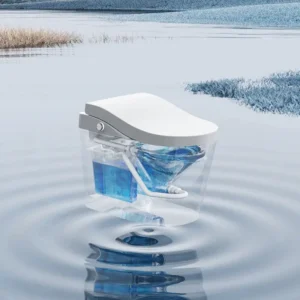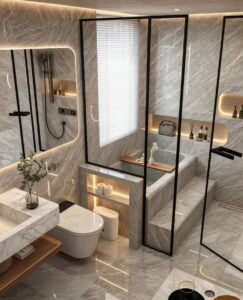Introduction
For developers and institutional investors operating in the competitive high-end residential and commercial real estate sectors, the selection of standard fixtures represents a crucial strategic decision. This report analyzes the financial and competitive necessity of integrating smart toilets as a standard component of luxury developments, demonstrating how this move elevates asset valuation, accelerates capital turnover, and provides superior operational efficiency. Smart technology is no longer a luxury upgrade; it is a foundational expectation that determines project credibility and future-proofs asset value.
The Shifting Luxury Imperative – Technology as a Foundational Expectation
Bridging the Gap Between Aesthetics and Automation
The luxury market demands architecture that transcends mere visual appeal; properties must be designed to "anticipate and adapt to the needs of their occupants". Connectivity and automation have therefore become essential infrastructure components, holding equal weight to structural design and spatial planning in modern construction standards.
This technological integration is directly linked to perceived project quality. High-end amenities, particularly in high-touch areas like the bathroom, function as powerful quality assurance signals. Developers often find that integrating a sophisticated fixture, such as the KOHLER Numi intelligent toilet, serves a strategic purpose: when prospective clients encounter an item of this complexity and quality, it "adds credibility to everything else we’re telling them about the project". This signals that the developer has paid attention to detail in every aspect of the build, mitigating buyer skepticism and validating the premium price point necessary for multi-million dollar investments.
Furthermore, standardizing smart toilets aligns projects with the growing consumer focus on wellness and high-end experience. Luxury is increasingly defined by personalized comfort and spa-like functionality. High-end buyers specifically seek amenities that are "atypical and unique," reflecting exclusivity. Smart toilets, with features like integrated bidets, heated seats, and ambient lighting, transform a mundane necessity into a sanctuary or "wellness ritual". This transformation yields measurable results; homes with spa-like bathrooms have been shown to sell for up to 4.6% more than those with outdated designs.
Quantifying Asset Value Uplift and Sales Velocity (The Residential Case)
The Direct Price Premium of Smart Technology
Investing in integrated smart technology results in a consistent and measurable property value premium. Industry studies and consumer reports indicate that general smart home technology integration can add between 3% and 5% to a property's overall value. For a $500,000 asset, this represents an addition of $15,000 to $25,000 to the final sale price.
Focusing on the smart bathroom specifically, market data confirms that high-impact fixtures correlate with higher valuations. Homes equipped with touchless toilets, a core feature of smart systems, have been sold for 0.7% more than expected compared to comparable properties. This measurable premium is amplified when the smart toilet is seamlessly integrated into a larger smart bathroom ecosystem (e.g., featuring smart mirrors or heated floors). The most significant value uplift, the 3% to 5% increase, is generated by selling the integrated system and the synergistic luxury experience, rather than marketing the fixture as a standalone gadget.
Accelerating Capital Rotation (Sales Velocity)
Beyond the final sale price, project profitability is heavily influenced by the speed of capital rotation. Carrying costs erode profit margins for every day a unit remains unsold. Integrating professionally installed smart features significantly reduces the average Days on Market (DOM). In competitive housing areas, listings equipped with integrated smart features are observed to move up to 40% faster compared to traditional listings.
This acceleration is vital for improving the Internal Rate of Return (IRR). Furthermore, standardizing smart technology helps future-proof the asset against obsolescence, particularly when appealing to younger, digitally native buyers. Research shows that 63% of millennials currently live in a smart home , and a strong majority are willing to pay more for residences with pre-installed smart amenities. Standardizing the smart toilet ensures the project directly addresses the expectations of this rapidly growing demographic.
The Commercial Imperative – NOI Enhancement and Operational ROI
Driving Net Operating Income (NOI) Through Rent Premiums
For commercial and multifamily property investors, the value proposition of smart bathrooms centers on reducing operational expenses (OpEx) and increasing rental revenue. Buildings that feature smart and automated amenities, including touchless smart bathrooms, can typically command 10% to 15% more in rent than those without. This direct increase in revenue immediately enhances Net Operating Income (NOI).
In the multifamily sector, the returns are often even stronger: 86% of millennial renters are willing to pay an average premium of 20% more in rent for smart apartments. High-quality commercial tenants view these sophisticated amenities as essential signals of modern building standards, leading to higher tenant satisfaction, better retention rates, and positive referrals.
Measurable Savings in Maintenance and Utilities
The initial higher investment in smart toilets is rapidly offset by tangible, long-term operational savings. Touchless functions, self-cleaning nozzles, and antimicrobial surfaces minimize facility maintenance requirements. Building managers commonly report up to 30% lower maintenance costs in smart bathroom installations compared to traditional fixtures.
The most compelling financial argument, however, lies in water efficiency. Smart toilets are High-Efficiency Toilets (HETs), often WaterSense-certified, using 1.28 gallons per flush (gpf) or less. By replacing older, inefficient 3 gpf commercial toilets with high-efficiency models, a property can reduce water consumption by over 50%. This dramatic reduction in utility expense translates to a highly favorable Return on Investment (ROI): simple payback on the fixture investment occurs in approximately 1 to 1.5 years, yielding a long-term ROI over 20 years exceeding 1,300% to 2,025% on utility savings alone. This re-frames the high initial expenditure as mandatory long-term cost optimization.
Feature Analysis – Defining the Standard Luxury Specification
Essential Comfort and Indulgence Features
Standard luxury specification requires features that balance luxury, hygiene, and sustainable operation:
-
Heated Seating: Adjustable seat temperatures are a core expectation for comfort.
-
Integrated Bidet and Drying: Customizable warm water pressure and warm air drying functions address personal preference and superior hygiene.
-
Hands-Free Operation: Motion-activated lids and automatic flushing minimize contact, which is crucial for modern hygiene expectations and convenience.
High-end models offer complete integration, including ambient lighting and app-controlled speakers. The ultimate goal is design simplicity; while the technology is complex, the user interface must be intuitive, prioritizing seamless control via remote or voice activation to prevent the complicated experience of poorly integrated systems. Developers should select tankless or sleek, wall-hung designs that align with the minimalist aesthetic expected by contemporary luxury buyers.
Strategic Implementation and Risk Mitigation (B2B Logistics)
Compliance and Standards for Mass Deployment
Large-scale deployment requires strict adherence to regional compliance and performance standards.
-
Water Efficiency: Specifying WaterSense-certified models (1.28 gpf or less) ensures compliance with water conservation regulations, which is essential for project approval and utility cost management. Premium commercial properties should aim for High-Efficiency Toilets (HET) using 1.1 gpf or less.
-
Accessibility: For commercial and residential projects, especially those targeting multi-generational living, compliance with ADA standards is necessary. This includes ensuring the toilet seat height is between 17 and 19 inches and that sufficient clearance space (60 inches minimum) is maintained.
Vendor Selection, Warranty, and After-Sales Service
The primary perceived risk for electronic fixtures is long-term reliability. Developers must mitigate this liability by prioritizing vendor commitments. While standard industry warranties typically range from 1 to 3 years , leading luxury manufacturers are now offering extended coverage, with some pledging up to 6-year warranties that cover the entire product, including all electronic and plumbing components. This extended protection directly addresses concerns regarding the electronic failure rate of high-cost fixtures.
To achieve maximum efficiency, developers must negotiate bulk pricing and secure exclusive supply agreements. Strategic partnerships with manufacturers are crucial for achieving economies of scale, reducing the unit cost, and ensuring dedicated technical support and readily available replacement parts, which minimizes facility downtime and long-term maintenance volatility.
Conclusions and Recommendations
Standardizing the smart toilet transforms it from a customizable personal indulgence into a core strategic infrastructure investment. The data confirms an undeniable financial case for this standardization: the confluence of asset appreciation (3% to 5% premium), accelerated sales cycles (up to 40% faster), and significant operational savings (utility ROI exceeding 1,300% over 20 years and 30% lower maintenance costs) offers a superior Return on Investment compared to conventional fixtures.
Real estate projects that adopt sophisticated smart bathrooms as standard are securing a defensible market position. As the global smart home market accelerates toward a projected valuation of $1.4 trillion by 2034 , integrated technology becomes fundamental utility, making its standardization essential for long-term asset defensibility and attracting the discerning, technologically advanced buyer of today and tomorrow.
Developer's Toolkit: Frequently Asked Questions (FAQ)
Addressing Developer and Investor Concerns
FAQ 1: What is the true ROI of installing smart toilets in bulk?
The ROI is multilayered, providing both revenue uplift and operational cost savings. On the revenue side, developers should expect a 3–5% property value uplift for integrated smart homes and 10–15% rent premiums in premium commercial or multifamily assets. On the cost savings side, water efficiency alone typically yields a payback period of approximately 1 to 1.5 years, resulting in a long-term ROI exceeding 1,300% over the asset lifecycle.
FAQ 2: Are smart toilets difficult to install or maintain in large-scale commercial projects?
Initial installation requires specialized planning for both plumbing and electrical setups, increasing complexity compared to conventional models. However, this complexity is justified by reduced long-term maintenance. Touchless features, self-cleaning systems, and real-time monitoring significantly lower the maintenance burden, with facility managers reporting up to 30% lower maintenance costs in smart bathroom installations.
FAQ 3: How long should I expect the electronic components to last, and what is the typical warranty?
Electronic components in smart toilets are subject to rigorous testing. While standard industry warranties for smart toilets generally range from 1 to 3 years , developers should prioritize securing long-term reliability. Leading luxury manufacturers now offer comprehensive warranties up to 6 years, covering all parts and electronics, which significantly mitigates the financial risk associated with component failure post-installation.
FAQ 4: How important is WaterSense and ADA compliance for my B2B project?
Compliance is critical for regulatory approval and operational efficiency. WaterSense certification (1.28 gpf or less) is mandatory for achieving maximum water conservation and utility savings. Furthermore, ensuring smart toilet placement and height comply with ADA requirements is vital for establishing long-term asset defensibility and ensuring accessibility, particularly for public or multi-generational residential developments.
Google 账号
Guangdong HTD Technology Co., LTD.
sally\@htdsanitary.com


